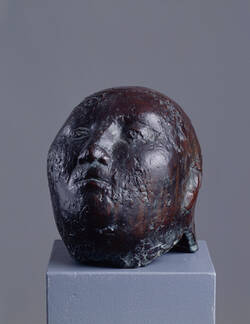Wieland Förster: Beaten Man and Head of the Paralysed Woman
When he was 15, Wieland Förster experienced the bombing of Dresden. After the war, he was accused of possessing weapons and, although he was innocent, spent four years in prison. He saw people dying and also feared for his own life – and afterwards he wanted to testify to what he had seen, to use his art as a memorial for those so ‘inhumanely murdered’. When Wieland Förster created his sculpture Beaten Man in 1989, he had no idea that years later this figure would literally become a memorial in Leipzig – to commemorate the Sinti and Roma murdered under the Nazi regime.
Although the pose of the cowering, crouching figure embodies pain, fear and despair, the round muscular shapes radiate a seemingly unbroken energy. Such an ambivalence is characteristic of Förster’s image of people which, despite the suffering, always has something powerful, energetic, and life-affirming.
In 1960, he had a crucial experience in his quest to express his view of the human figure. One night he saw a young woman standing above him on a staircase, her head lifted to gaze at the moon. From his perspective, her head appeared as an egg-shaped oval form. His discovery was so vivid and powerful, he adopted the shape as a touchstone and fundamental element in his oeuvre. It is especially prominent in his Head of the Paralysed Woman – a portrait of a woman who lived near him in Berlin. Wieland Förster admired her for the way she managed her life, despite all her limitations:
“For her, lighting the stove was more difficult and dangerous than the achievements of many acclaimed ‘heroes’. And that is what interested me especially.”
Wieland Förster was successful as a sculptor, even though his works did not always conform to the precepts of art approved in the GDR. For instance, his Head of the Paralysed Woman and other depictions of suffering contradicted the officially sanctioned optimistic image of the human figure. In 1968, this led to Förster being banned from working as an artist and exhibiting. He was later rehabilitated in the 1970s.
Further Media
- Location & Dating
- 1989
- Material & Technique
- Bronze
- Dimenions
- H: 71 cm, B: 36,5 cm, T 56,5 cm
- Museum
- Skulpturensammlung
- Inventory number
- WF 044
